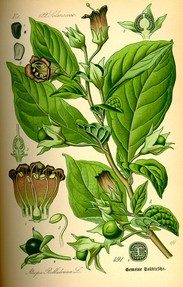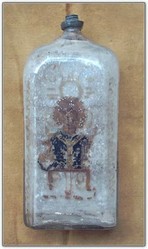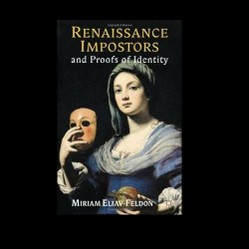 The story we have today is not told very often for several reasons. Her story hasn't survived as Lucretia's has, because we don't have the family's fame, or the family portraits. Both Giulia and her mother were supposed to have been very beautiful women. However, while a portrait of a young woman holding a unicorn is being shown online as Giulia's portrait, that is not true. There are no known surviving portraits of her. If Giulia's poison was her craft, she also kept it under wraps for very practical reasons, including survival and the ability to continue to make a living. And her story was told only after her death, not while she was alive, powerful, young and beautiful. So she wasn't there to motivate the gossips and keep the story going.
The story we have today is not told very often for several reasons. Her story hasn't survived as Lucretia's has, because we don't have the family's fame, or the family portraits. Both Giulia and her mother were supposed to have been very beautiful women. However, while a portrait of a young woman holding a unicorn is being shown online as Giulia's portrait, that is not true. There are no known surviving portraits of her. If Giulia's poison was her craft, she also kept it under wraps for very practical reasons, including survival and the ability to continue to make a living. And her story was told only after her death, not while she was alive, powerful, young and beautiful. So she wasn't there to motivate the gossips and keep the story going.
However, Giulia and her family did add to the general perception that women were devious and their method of killing was poison. Even Mozart a couple of centuries later told his wife that his impending death was probably due to being poisoned. (However, his death is thought to have been made more likely by excessive blood letting when he was in a debilitated condition.)
This was how both she and her clients wanted it. While she also sold to men, her poison was almost exclusively given to men. After all, poison is usually only given to someone who has some power to cause harm or to bestow property and power. Back then, it was a rare woman who had any of these attributes.
She provided what could be called an early Italian divorce for many unhappy wives. If they didn't want to enter a convent, women in Italy during that time had only three ways to make a living; they married, they begged or they prostituted themselves. While the last two options had their own obvious shortfalls, there were many powerless married women, many of whom were also at risk. Women died frequently in childbirth - even Lucretia Borgia, a woman from an immensely powerful family, died of complications after the birth of her eighth child. Women were beaten, mistreated, and powerless. Well, and some women just hated their husbands. In these circumstances, a much better option was to become a widow.
So Giulia's clients were very protective of her. They told only others whom they could trust and who had the same needs. After all, if the authorities found this particular merchant, not only the merchant, but the clients would swing for engaging in the transaction.
Giulia was very good at her craft. She may have came by it honestly, as her mother is thought to be, Thofania d'Adamo, who was executed for murdering Francis, who was either Guilia's father or a later husband. (Which begs the question, was Giulia's father an earlier poisoning?)
She was known to be beautiful, and was very interested in apothecaries. She befriended many and learn a great deal. Aqua Tofana, a poison mixture of arsenic, lead and Bella Donna was named after her, but it may have been a poison handed down from her mother. Even so, Giulia could still have refined it. The poison was known to be tasteless, odorless and colorless - especially handy for mixing with wine and other liquids. Only a small amount was required to complete the poison, and the combination of ingredients masked the known symptoms of poison, such as seizures and intense pain. Thankfully, while most of the ingredients are still known, information about the proportions and the method of mixing has not survived.
Some sources list Giulia as a young widow when she started her business. This raises the question of how she tested the perfection of her product. At any rate, she sold it under the cover of cosmetics, or as vials of "Manna of St. Nicholas of Bari". When it was sold in vials with the St. Nicholas label, the cover was that it was a devotional object. At any rate, it fooled the authorities for almost 50 years.


 The story we have today is not told very often for several reasons. Her story hasn't survived as Lucretia's has, because we don't have the family's fame, or the family portraits. Both Giulia and her mother were supposed to have been very beautiful women. However, while a portrait of a young woman holding a unicorn is being shown online as Giulia's portrait, that is not true. There are no known surviving portraits of her. If Giulia's poison was her craft, she also kept it under wraps for very practical reasons, including survival and the ability to continue to make a living. And her story was told only after her death, not while she was alive, powerful, young and beautiful. So she wasn't there to motivate the gossips and keep the story going.
The story we have today is not told very often for several reasons. Her story hasn't survived as Lucretia's has, because we don't have the family's fame, or the family portraits. Both Giulia and her mother were supposed to have been very beautiful women. However, while a portrait of a young woman holding a unicorn is being shown online as Giulia's portrait, that is not true. There are no known surviving portraits of her. If Giulia's poison was her craft, she also kept it under wraps for very practical reasons, including survival and the ability to continue to make a living. And her story was told only after her death, not while she was alive, powerful, young and beautiful. So she wasn't there to motivate the gossips and keep the story going.







 SS Eastland - The Poor Man's Titanic Sank with A Great Loss of Lifeon 10/28/2012
SS Eastland - The Poor Man's Titanic Sank with A Great Loss of Lifeon 10/28/2012



Comments
Thank you, cmoneyspinner. This was an interesting woman to research - I couldn't believe how long she got away with it.
Poisoning husbands? OK. That's believable.
But motivating gossip to keep a story alive if she were alive?
I don't believe it!
This was a gooooood article!